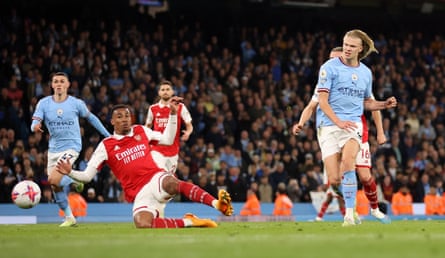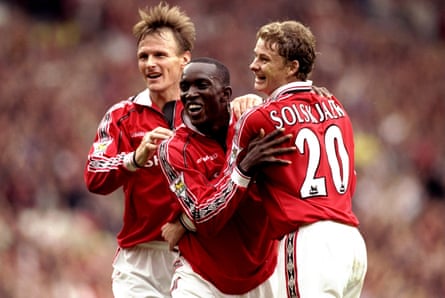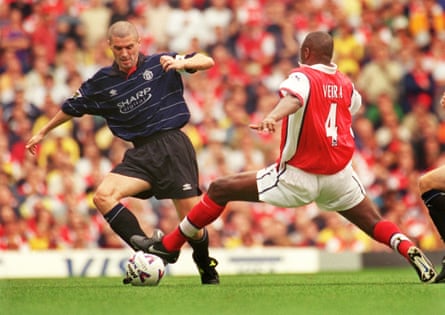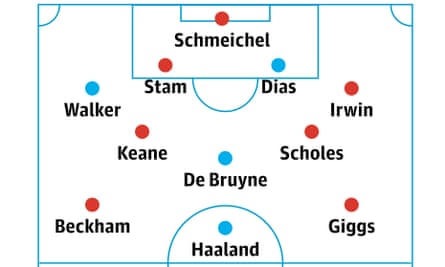How the season unfolded
Manchester United: Sir Alex Ferguson’s team were masters of harum-scarum wins in defining matches. To claim the Premier League on the final day Tottenham had to be defeated but after 24 minutes a Les Ferdinand goal stunned Old Trafford before United, in blazing sunshine, staged a memorable comeback via David Beckham and Andy Cole. In the FA Cup fourth round United were 1-0 down to Liverpool until the 88th minute, then finishes from Dwight Yorke and Ole Gunnar Solskjær knocked out their great rivals. In semi-final extra time Ryan Giggs’s wonder solo effort eliminated Arsenal and in the Champions League semi-final second leg in Turin Juventus pulled 2-0 ahead on the night (3-1 on aggregate) via a Filippo Inzaghi double before a Roy Keane-inspired turnaround beat the Italian club. Then there was the cartoon-like end to the final: down 1-0 in added time to Bayern Munich, the substitutes Teddy Sheringham and Solskjær scored to put United in dreamland and clinch the treble.
Manchester City: When Pep Guardiola’s men lost to United on 14 January and Arsenal beat Tottenham the next day Mikel Arteta’s side moved eight points clear. A month later it was all square after City won 3-1 at the Emirates Stadium, having played a game more. Although City immediately dropped points at Nottingham Forest, they then put together a sequence of wins, including over Arsenal, until the title was won. The FA Cup campaign was serene, ending as a 19-1 aggregate triumph across their six matches, the one goal conceded coming from a United penalty in the final. The Champions League (so far) has been similar. In the group stage, 14 goals struck, two conceded and zero defeats. The knockout phase has brought emphatic aggregate wins against RB Leipzig (8-1), Bayern Munich (4-1) and Real Madrid (5-1).

How the tactics compare
Manchester United: Ferguson’s team were a fluid 4-4-2, with Dwight Yorke (or his deputy Sheringham) often dropping off the front and Ryan Giggs floating inside from the left to make it a quasi 4-2-3-1, with Cole at the tip and Beckham pushing up from midfield. This left Keane and Paul Scholes as a classy central duo in front of a rock-solid back four containing Gary Neville and Denis Irwin, the full-backs who would bolster the attack, plus Jaap Stam, one of United’s greatest centre-backs, and either Ronny Johnsen or Henning Berg. In goal was the outstanding Peter Schmeichel.

Manchester City: This term’s major addition has been Erling Haaland, whose 36 goals from 35 Premier League appearances is a storybook achievement in his first English season. Although his arrival caused City to recalibrate – at times awkwardly – they are, again, the smooth-passing technical proposition who hog possession and know when to thrust forward. From the delivery of Ederson, a goalkeeper uber-comfortable using his feet, the defenders Walker, Rúben Dias, John Stones and, latterly, Manuel Akanji initiate attacks which course through Rodri and Stones (who often steps upfield). From the wings Jack Grealish (or Phil Foden) and Bernardo Silva (or Riyad Mahrez) are instructed by Guardiola to dart at opponents aggressively while Ilkay Gündogan glides about scheming, and the peerless Kevin De Bruyne is the master of the pass that releases Haaland.

The key players
Manchester United: So many. Schmeichel may be United’s greatest ever goalkeeper, Irwin in the same rank at left-back, and Giggs, too, has a case for being in the club’s all-time XI. If Scholes might be squeezed out of that by Bobby Charlton, Keane is the clear standout footballer of the 99 vintage, an on-field personification of Ferguson, the driving force who refused to lose – his header sparked the comeback in Turin – and whose relentless demand for excellence cast him as a captain for the ages. He was suspended for the Champions League final but United performed in his (and Ferguson’s) never-say-we-have-lost image.

Manchester City: De Bruyne walks, surely, into a best-ever Premier League XI, along with Haaland and Walker, while Ederson is in the shake-up to be a reserve to Schmeichel. Dias’s cold-eyed focus and natural leadership make him a formidable defender while Gündogan’s ability (seemingly) to pad about unnoticed, killing opponents with his vision and penchant for scoring when it counts (each of City’s goals in the Cup final, for example) is matched by Grealish’s emergence, in his second season, as a direct wide man who breaks lines. Mahrez, Foden (who has been hampered by injury), Julián Álvarez (a Qatar 2022 World Cup winner with Argentina) and the youngster Rico Lewis are a glittering support cast.

The weak spots
Manchester United: Berg and Johnsen taking it in turns to partner Stam in central defence points to an obvious vulnerability in the backline and Neville’s rudimentary talent makes the right-back area one that could have been improved too. It is otherwise difficult to pick holes, which is no surprise. Beckham’s precise crossing and pinpoint passing suggested he was a natural central midfielder (where he operated versus Bayern) stationed on the right, but if his sluggish pace was not that of the classic wingman, the side’s style and Beckham’s feisty attitude make this a non-factor.
Manchester City: Left-back (kind of). João Cancelo’s falling-out with Guardiola over reduced game time ended in the Portuguese becoming footballer non grata and being loaned to Bayern in the winter window. So with Oleksandr Zinchenko previously sold to Arsenal and Sergio Gómez not meeting the Guardiola standard, a job share featuring Nathan Aké, Aymeric Laporte, Silva (very rarely) and Akanji has been the manager’s solution, with the last of these the most trusted. The overall speed of the defence has been a point of scrutiny given that City’s high line can be exposed. That does not apply to Walker because the right-back, at 33, seems to be getting even faster.
Combined XI


